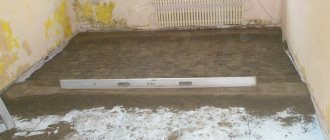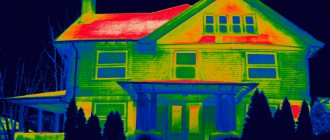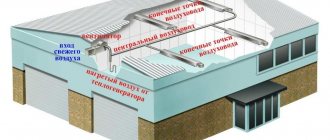A modern heating system in a private home is a prerequisite for comfortable living indoors throughout the year. Today you can easily select any equipment and components that allow you to create a reliable, economical, efficient heating system for buildings and structures of any size. A prerequisite for creating a comfortable microclimate in the house is correct calculations of the heating system. They will require not only knowledge of the power of the equipment planned for installation, but also the area of the room that needs to be heated. How is the heated volume of a building calculated correctly, and is it possible to perform these calculations yourself?
When drawing up a building project regarding a future structure, four concepts are used:
- Room area. It represents the dimensions of the room, which are determined by the distance between opposite walls without taking into account the baseboards. If the house has a stove or fireplace, their dimensions must be excluded from the calculated indicator.
- Total area of the building. What is included in the total area of the house is one of the important issues characterizing the premises. This indicator includes all premises of the residential and non-residential sector, and even built-in wardrobes.
- Living space. It consists of the sum of the sizes of all living rooms - living room, bedrooms, children's rooms and offices, wardrobe. Contrary to the erroneous opinion of many residents, the kitchen is included in the living area of the house.
- Effective area. It is calculated as a total indicator of the sizes of all rooms with the exception of stairs, ramps, and staircases.
One of the main questions when collecting information is what is included in the total area of a residential building - which of the categories of calculated indicators do the veranda and terrace belong to? By analogy with balconies and loggias in apartment buildings, these areas are taken into account when determining the total area of living space.
Heated room: concept and features
The heated volume of a building is the part of the room where heating devices and their elements are installed, designed to maintain the required temperature during the heating season. How to determine the volume of a room that requires maintaining the set temperature?
According to current regulatory documentation, the heated size of a house consists of the total area of the house's premises. Correct calculation of the heated volume of a building is important when planning a heating system and for the upcoming replacement of heating radiators, regardless of the type of system (water, gas, electric, solid fuel). The operating efficiency and durability of the system are directly related to several parameters:
- correct calculations of the heated area;
- quality of the equipment used;
- boiler power;
- Type of equipment;
- correct installation.
The heated area of the building is one of the key parameters for the upcoming calculations. It is with this that the correct determination of the boiler power and the number of sections of installed radiators is associated. Why is it important? Incorrect calculation of the required number of heating batteries will lead to one of two negative consequences:
- poor air heating in rooms;
- uneconomical, excessive consumption of heat (unjustified waste of funds).
Since the heated part of the house includes all rooms, it is important not only to correctly understand what is included in the concept of living area of the house, but also to take into account all utility rooms without exception. The simplest way to determine the required number of radiators during system planning is to count the number of windows in the house. Traditionally, radiators are installed under or close to windows, and in general, the system for calculating heat consumption for standard rooms is not difficult, but general calculations for the entire house must include additional parameters and design features of the building.
Understanding what is included in the living space of a private house is not enough to correctly determine the volume of the heated room and calculate the power and the amount of necessary equipment.
Additionally, you need to take into account design features:
- in a corner room with one window, the calculated radiator power should be increased by 20%, with two - by 30%;
- when installing the battery in a special niche near the window, the loss of heat transfer is compensated by an additional addition of 5% to the radiator power;
- under windows facing north or northeast, you need to install a radiator with a power increased by 10% of the standard design value;
- the presence of double-glazed windows allows you to reduce the estimated power of batteries by 10-15%;
- if there is no door between two adjacent rooms, you need to take the total size of these rooms.
Having figured out what is considered living space in a private house, which rooms additionally require constant maintenance of a fixed temperature during the heating season, you can calculate the heated volume.
https://youtu.be/p9TV9GRBFJU
Calculator for calculating heating radiators by area
The area register calculator is the easiest way to determine the required number of radiators per 1m2. Calculations are made based on power production standards. There are 2 main requirements of the norms, taking into account the climatic characteristics of the region.
- For temperate climates, the required power is 60-100 W;
- For northern regions the norm is 150-200 W.
Many people are interested in why the standards have such a wide range. But the power is selected based on the initial parameters of the house. Concrete buildings require maximum power ratings. Brick - medium, insulated - low.
All standards are taken into account with an average maximum shelf height of 2.7 m.
To calculate the sections, you will need to multiply the area by the norm and divide by the heat transfer of one section. Depending on the radiator model, the power of one section is taken into account. This information can be found in the technical data. Everything is quite simple and does not present any particular difficulties.
How to calculate the heated volume of a building?
How to calculate the heated area of a building so that the functioning of the heating system ensures optimal temperature in the premises? The heated volume of the building is calculated by the formula: floor area * internal height, where the internal height is defined as the value from the floor surface of the first floor to the ceiling surface of the last floor. In one-story buildings, the internal height is taken to be measured from floor to ceiling.
The heated area of the building does not include the dimensions of warm attics and basements, cold unheated verandas, and cold attics. If the building structure is too complex, making the necessary measurements becomes significantly more difficult. In this case, a simplified system for calculating the heated volume of a building is allowed: it is necessary to measure the volume of space limited by the inner part of the outer fence and accept the resulting calculations as the required value.
Calculator for simple calculation of heating radiators per area
The calculator is an effective calculation option. For a room measuring 10 square meters, you will need kW (1000 W). But this is provided that the room is not corner and double glazed windows are installed. To find out the number of fins of panel devices, you need to divide the required power by the heat transfer of one section.
In this case, they take into account. If they are higher than 3.5 m, then the number of sections will need to be increased by one. And if the room is corner, then add plus one compartment.
The thermal power reserve is taken into account. This is 10-20% of the calculated figure. This is necessary in case of extreme cold.
The heat transfer of the sections is specified in the technical data. For aluminum and bimetallic batteries, the power of one section is taken into account. For cast iron appliances, the heat transfer of the entire radiator is taken as a basis.
What is included in the total area of an apartment in Russia in 2022
It is possible to calculate the full cost of real estate Correctly estimate the purchase price Drawing up an explication, technical passport for the apartment As well as other accompanying documents for real estate This parameter will be needed when selling In order to justify the value of real estate to a potential buyer When carrying out redevelopment You will need to make the calculation yourself
- object of housing rights;
- living space;
- apartment area;
- unsuitable for habitation;
- auxiliary premises.
Object of housing rights Premises that are recognized as residential. Accordingly, in order for an apartment to be recognized as a residential premises, it must have the main features of such and meet standard requirements. They are determined for each type of real estate. Apartment area. Standard parameter that is taken into account primarily when calculating the cost of housing. Unsuitable for habitation. The condition of the premises when it cannot be used for its intended purpose. Moreover, there must be a recognition as unsuitable in the standard manner established
Please note => Law In September On Demolition Of Emergency Housing In 2019
Calculator for accurately calculating the number of heating radiator sections
A simple calculation does not take into account many factors. The result is distorted data. Then some rooms remain cold, others too hot. The temperature can be controlled using shut-off valves, but it is better to accurately calculate everything in advance in order to use the right amount of materials.
For accurate calculations, decreasing and increasing thermal coefficients are used. First you should pay attention to the windows. For single glazing, a coefficient of 1.7 is used. Double windows do not require a factor. For triples the figure is 0.85.
If the windows are single and there is no thermal insulation, then the heat loss will be quite large.
When calculating, take into account the ratio of the area of floors and windows. The ideal ratio is 30%. Then a coefficient of 1 is applied. When the ratio increases by 10%, the coefficient increases by 0.1.
Coefficients for different ceiling heights:
- If the ceiling is below 2.7 m, the coefficient is not needed;
- For indicators from 2.7 to 3.5 m, a coefficient of 1.1 is used;
- When the height is 3.5-4.5 m, a coefficient of 1.2 will be required.
In the presence of attics or upper floors, certain coefficients are also applied. For a warm attic, an indicator of 0.9 is used, for a living room - 0.8. For unheated attics take 1.
Is the balcony included in the total area of the apartment?
3.37. The total area of the apartment is determined as the sum of the areas of its premises, built-in wardrobes, as well as the areas of loggias, balconies, verandas, terraces and cold storage rooms, calculated with the following reduction factors: for loggias - 0.5, for balconies and terraces - 0.3, for verandas and cold storage rooms - 1.0. The same is said in the mandatory Appendix No. 2 to SNiP 2.08.01-89. Paragraph 2 of the Appendix states “The total area of apartments should be determined as the sum of the areas of their premises, built-in wardrobes, as well as loggias, balconies, verandas, terraces and cold storage rooms, calculated with the following reduction factors: for loggias - 0.5, for balconies and terraces - 0.3, for verandas and cold storage rooms - 1.0.”
A heated loggia is included in the total area of the apartment
Sometimes the developer misleads participants in shared construction, claiming to buyers that he is guided by the housing legislation of the Russian Federation. For example, it imposes information on clients - buyers that certain additional rooms in the apartment do not belong to the living space, although this space is paid for when purchasing. The total area of an apartment should be considered (according to a certain article of legislation) the total amount of area of all the premises that are included in it. Additional premises that satisfy the needs of apartment residents are also taken into account when calculating the total area.
What is included in the total living area of the apartment?
According to the current rules for designating the total footage, the total area of your apartment must be understood as the result of the addition of all square meters of its heated and unheated rooms and premises, as well as those calculated using reducing indicators. An accurate understanding of how the reduction factor is used when calculating the square footage of individual premises will save you from misunderstandings and unpleasant surprises. If you were unable to protect yourself from such shortcomings, then only an appeal to the judicial authorities can restore justice.
Volume calculator for calculating heat for heating a room
Similar calculations are used for rooms that are too high or too low. In this case, it is calculated based on the volume of the room. So for 1 cubic meter you need 51 W of battery power. The calculation formula looks like this: A=B*41
- A – how many sections are needed;
- B is the volume of the room.
To find the volume, multiply the length by the height and width. If the battery is divided into sections, then the total demand is divided by the power of the whole battery. It is customary to round up the resulting calculations, since companies often increase the capacity of their equipment.











